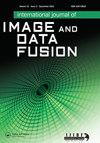一种基于分水岭分割和IHS图像融合的多焦点图像融合方法
IF 1.8
Q3 REMOTE SENSING
International Journal of Image and Data Fusion
Pub Date : 2020-07-29
DOI:10.1080/19479832.2020.1791262
引用次数: 3
摘要
高倍率光学相机,如显微镜或宏观摄影,不能捕捉到完全聚焦的物体。在这种情况下,图像采集是通过使用一组不同焦点的图像用相机捕获物体/场景,然后融合产生一个“全焦点”图像,到处都是清晰的。这个过程被称为多焦点图像融合。本文提出了一种基于灰度色相饱和度分水岭(WIHS)的多焦点图像融合方法。首先,采用IHS图像融合技术对散焦图像进行融合;然后利用标记控制分水岭分割算法对融合后的图像进行分割。最后,利用拉普拉斯算子和修正法对多焦点图像在各区域上的焦点进行测量,并从其对应的图像中选择焦点测量值较高的区域来计算得到的全焦点图像。实验结果表明,与其他方法进行定量比较,WIHS具有最好的性能。本文章由计算机程序翻译,如有差异,请以英文原文为准。
A multi-focus image fusion method based on watershed segmentation and IHS image fusion
ABSTRACT High magnification optical cameras, such as microscopes or macro-photography, cannot capture an object that is totally in focus. In this case, image acquisition is done by capturing the object/scene with the camera using a set of images with different focuses, then fusing to produce an ‘all-in-focus’ image that is clear everywhere. This process is called multi-focus image fusion. In this paper, a method named Watershed on Intensity Hue Saturation (WIHS) is proposed to fuse multi-focus images. First, the defocused images are fused using IHS image fusion. Then the marker controlled watershed segmentation algorithm is utilized to segment the fused image. Finally, the Sum-Modified of Laplacian is applied to measure the focus of multi-focus images on each region and the region with higher focus measure is chosen from its corresponding image to compute the all-in- focus resulted image. The experiment results show that WIHS has best performance in quantitative comparison with other methods.
求助全文
通过发布文献求助,成功后即可免费获取论文全文。
去求助
来源期刊

International Journal of Image and Data Fusion
REMOTE SENSING-
CiteScore
5.00
自引率
0.00%
发文量
10
期刊介绍:
International Journal of Image and Data Fusion provides a single source of information for all aspects of image and data fusion methodologies, developments, techniques and applications. Image and data fusion techniques are important for combining the many sources of satellite, airborne and ground based imaging systems, and integrating these with other related data sets for enhanced information extraction and decision making. Image and data fusion aims at the integration of multi-sensor, multi-temporal, multi-resolution and multi-platform image data, together with geospatial data, GIS, in-situ, and other statistical data sets for improved information extraction, as well as to increase the reliability of the information. This leads to more accurate information that provides for robust operational performance, i.e. increased confidence, reduced ambiguity and improved classification enabling evidence based management. The journal welcomes original research papers, review papers, shorter letters, technical articles, book reviews and conference reports in all areas of image and data fusion including, but not limited to, the following aspects and topics: • Automatic registration/geometric aspects of fusing images with different spatial, spectral, temporal resolutions; phase information; or acquired in different modes • Pixel, feature and decision level fusion algorithms and methodologies • Data Assimilation: fusing data with models • Multi-source classification and information extraction • Integration of satellite, airborne and terrestrial sensor systems • Fusing temporal data sets for change detection studies (e.g. for Land Cover/Land Use Change studies) • Image and data mining from multi-platform, multi-source, multi-scale, multi-temporal data sets (e.g. geometric information, topological information, statistical information, etc.).
 求助内容:
求助内容: 应助结果提醒方式:
应助结果提醒方式:


